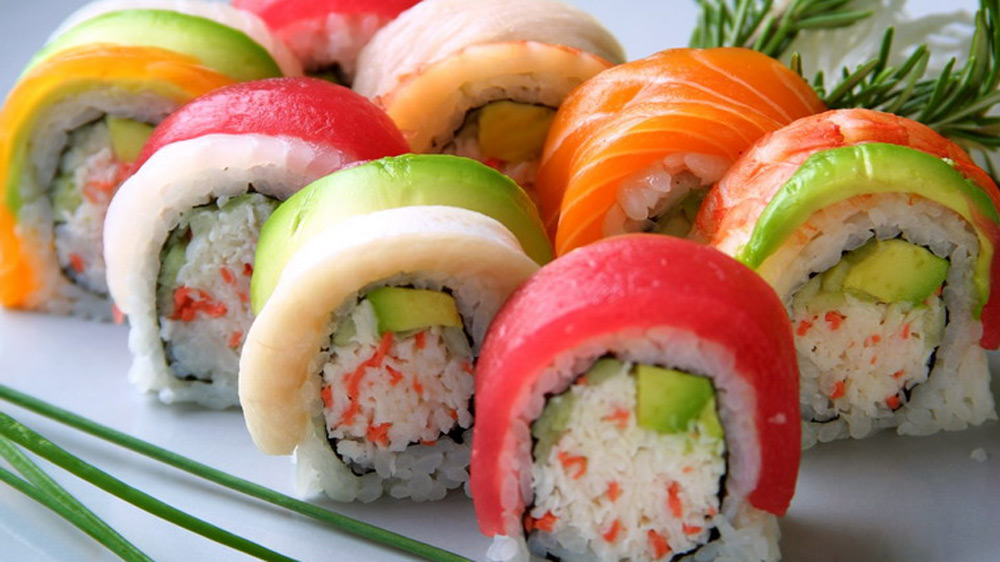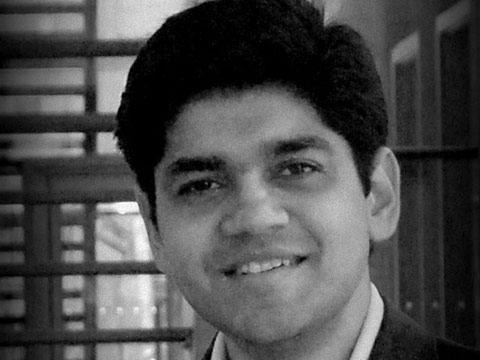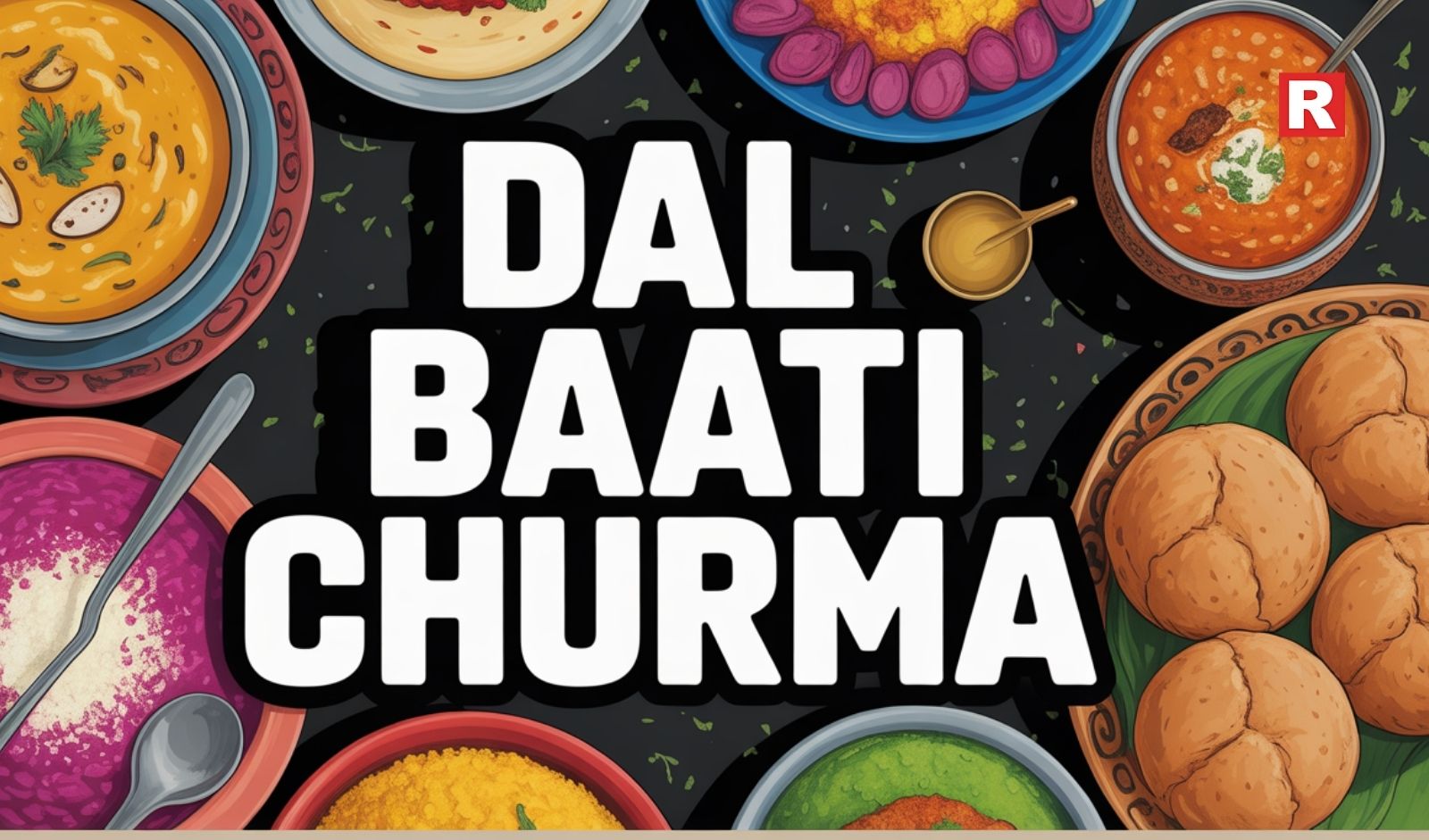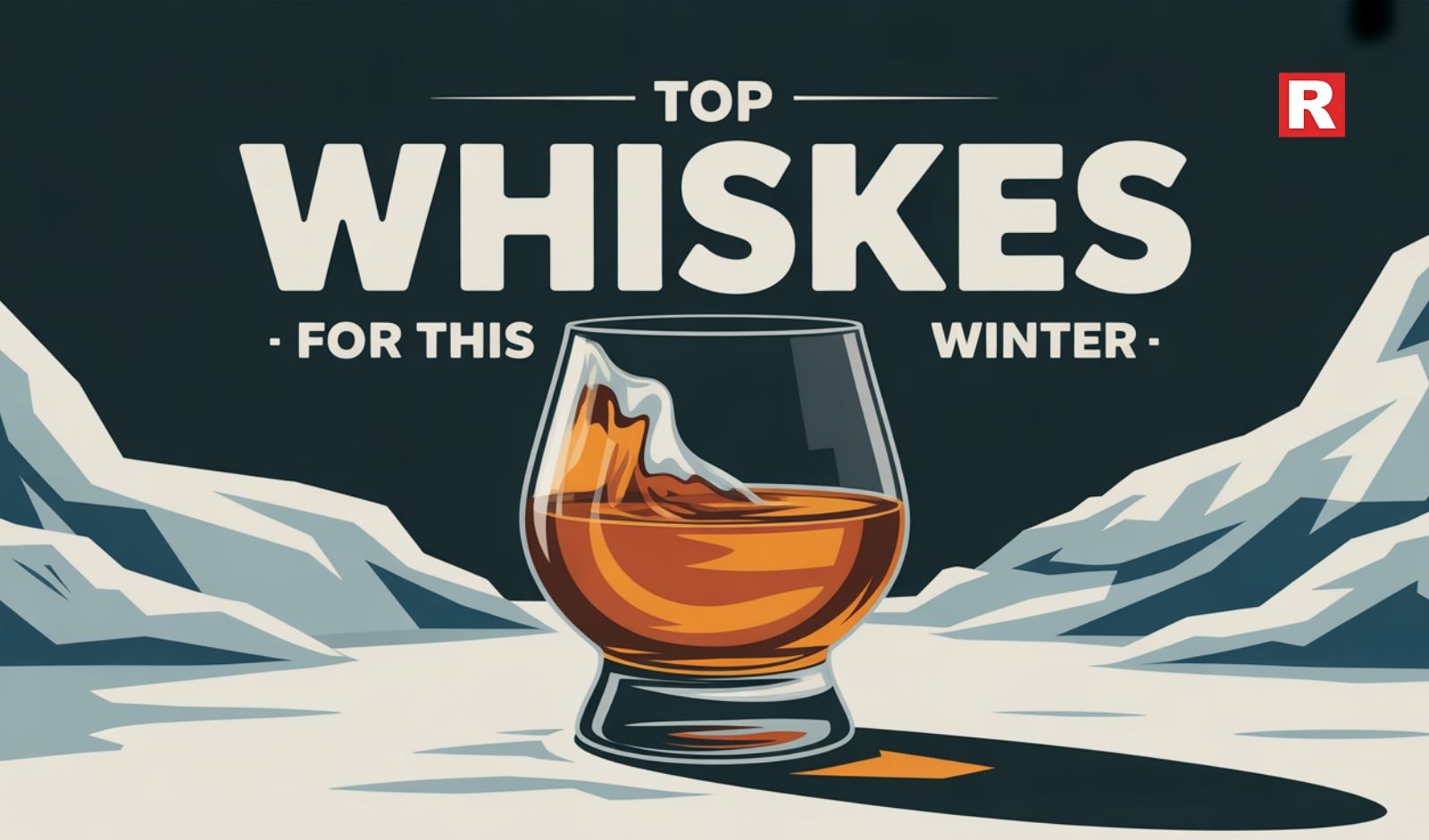
Food-tech sector has witnessed a new set of growth in last two years, as the ease and the options that these food-tech players provide has already made online food delivery a darling in most Indian cities. Also, a recent study by the Indian Brand Equity Foundation concluded that India’s food delivery market alone is worth $15 billion today. In yet another study, conducted by business consultancy firm Market Research Future, it was found that the food delivery market of the country is likely to grow at over 16 per cent annually and touch $17.02 billion by the year 2023.
The Pre-Aggregator Era
“When we started in 2013 we knew that biryani was liked at every home and could be scaled at the likes of McDonald’s, Domino’s or Pizza Hut. There was no Swiggy or Zomato and at only one store we were 70 per cent delivery brand,” shares Raymond Andrews, Co-Founder, Biryani Blues that has tied up with all major delivery players apart from their own delivery network. “Since then we have come a long way and for us the ration of dine-in v/s delivery remains the same,” he adds. But after the market of these aggregators in the initial 3-4 years they really helped restaurant brands to scale. With the aggregator business the pie has really grown while it has become a level-playing field for a lot of newer competitions and customers to get better access to ordering and everything, the per centage of delivery has really grown. “In the last two years we have seen more people logging in online and from different age group. It is the new ease and comfort that people are getting use to,” he further explains.
Getting Friend zoned: “We don’t mind having more access point to customers because that’s what matters. With aggregators coming into the food category, customers have extra incremental touch, access points,” adds Prashant Gaur, CBO, Pizza Hut India who believes that you only make your brand available to the largest set of people who would have probably otherwise not come to you through these online aggregators. That’s the way these brands look at this entire ecosystem. “When I go back to 2013-14 at my initial days with QSRs at Domino’s we guys felt that food aggregators are our enemy. Later, we realized that more and more customers are able to order online which is incremental to the business and they are not our enemy. And, now we have reached the stage where we fairly believe that if you have set the ground rule right, you know how to work with them in a more collaborative and defined way they will be your friends,” he shares laughing.
How Incremental were Aggregators: “We have always been in the aggregator era as our brand started with the same bang. Zomato and Swiggy are doing more than a million orders a day which is huge. So, definitely the whole food delivery segment, the kind of service they have given, more and more consumers look forward if the food can be delivered at home,” points Vishal Jindal, Co-Founder, Biryani by Kilo. There’s no denying that they are a big part of the business. Going forward, if we look at China the online food delivery is huge there and same is going to happen in India.
Comparing the bottom line growth: The bottom line growth is not just the factor of aggregator fees and how much you have to spend on advertising. It is about how much we have evolved in last five years in other operational efficiencies. “I think it’s the same. We work on certain target or numbers and everything passed back on the customer. So, if we make more into something it will probably pass into pricing or would do a different offer or something like that,” adds Andrews who was very clear in the new era of aggregators where they have to dish out discounts, commission and distribution costs etc. And, we have been able to work on other operational costs like the kind of manpower we work, spaces we sign up, the procurement and the logistic costs etc. So, we have been able to afford the larger scale business that’s coming through these aggregators.
Hence, we can say that aggregating platforms area happy place for the customers because of the convenience of choosing from different options-but a challenge for restaurants to keep standing out.

Product plays a very important in any business and especially in the food business where people go to a restaurant or order from a restaurant or dark kitchen players online just for its food. It remains the base of any restaurant business.
Combining offline experience into the digital world
“My father is of the view that you should do only one product at a time. When you are doing kebab, do only kebabs and when you are doing biryani, focus on it only,” shared Ahsan Qureshi, Co-Founder, Cross Border Kitchens whose father Padma Shri Imtiyaz Qureshi was one of the first few chef to make Indian food famous globally. “He will be very excited in terms of spread of our kitchen. When he used to cater there was no online delivery, online marketing etc and he is very excited about the concept I am doing,” he said proudly.
Going forward people will also look at separate window for delivery and takeaway. And, restaurants will have to prepare a designated area and a staff member to handle these orders. Servers interacting with diners should also collect orders from the kitchen entrance itself.
“ Lite Bite Food was started with one outlet by selling subway sandwiches and it was the passion for food that company has grown to more than 200+ outlets today. It is the product that matters whether you are selling it online or offline. If you have the right product available, there is always a lot of a taker for that,” said Vineet Manocha, VP- Culinary, Lite Bite Foods that has done a lot of research on what food works well and what travels well. “We have modified our menu, modified some ingredients. And, a lot of research went into packaging because it is an important aspect when the food has to travel. We have taken a lot of time checking what is working, what is not working, how long does biryani last in a particular packet,” he added further.
Clubbing experience
There’s something that happens every couple of year and the sector, people have to come across it, bear the result. “When we opened a couple of years back in 2008, we had recession that happened. And, there is something around the corner. We are in the business where various things affect our business and that kind of teaches you to always be ready for a rainy day and hang in there. Having been running restaurant business for a while we wanted to diversify the business and also as delivery is becoming order of the day,” pointed Chiquita Gulati of Spice Market whose concpet Call Chotu is a modern Indian take whereas Nayi dilli k parathe is a take on parathe which is a must for all delhites.
Commenting on the same Anshul Khandelwal, Head of Marketing, Category and Revenue shared, “We always had inspiration to manufacture food rather than deliver food. The value is actually in creation and not in delivery of food in long term.” He also pointed that their heart was always about creating brand and not delivering food. It’s been only six months since they have really started their business. “We are doing around 40 kitchens in India in our 6 cities and one of which is the khichdi experiment which in just six month is one of the most loved concept,” he added by pointing that the reason they are doing is that India really needs a large national brand instead of big global QSRs. There is no Indian brand which is present pan-India across every city and has created a food revolution.
And, as we know that China eats 30-40 per cent of their meal outside home whereas in India it is less than 10 per cent. So, there is a huge opportunity to culturally shift this and also there is a need to have trust in ordering food from outside. “We intend to create large multi-crore pan Indian food brand,” concluded Khandelwal.

The Delhi government on Thursday shut restaurants in the national capital region in the wake of the novel coronavirus outbreak but said that takeaway and home delivery services will continue.
"Lieutenant Governor Anil Baijal has asked all government departments, autonomous bodies and PSUs to segregate activities and suspend non-essential services," said Delhi chief minister Arvind Kejriwal at a press conference.
Also Read: McDonald’s closes dine-in in Delhi-NCR, to serve customers via Delivery
Seeing the outbreak all top brands in the city and even across the country have announced delivery and takeaway as an option during this distress time.
KFC: The brand is sanitizing all restaurant areas at regular intervals through the day that includes frequent sanitizing of tables, counters, doors and door handles every 30 minutes. With offices and institutions across the country declaring work from home, they also encourage consumers to reach them through alternate channels, including take-away and ordering in – as per their convenience. “Our delivery teams wash and sanitize their hands, alongside sanitizing delivery bags, after delivering each order. We are also launching ‘Zero Contact Delivery’ service, which will ensure that our trained delivery member will deliver food at the consumer's doorstep, without any contact with the consumer for prepaid orders,” shared a KFC Spokesperson adding that the riders will follow a strict protocol of wearing masks and hand gloves at all times during the delivery process.
“With impeccable global standards, reputed suppliers and transparent operations that allow consumers access to our kitchens, KFC is a brand that consumers have always trusted. To ensure health & safety of our consumers as well as team members in the current situation, we have rapidly put in place stringent operational protocols,” the spokesperson added.
Tacobell: “The health and safety of our employees and consumers is of utmost priority. Hence, we have taken additional measures, above and beyond our existing hygiene best practices like increasing the frequency of hand washing and sanitizing,” shared a Tacobell spokesperson who have increased the frequency of sanitization of their stores, with surfaces like tables, chairs, doors and door handles, being wiped down and cleaned thoroughly. “Our kitchen staff use gloves at all times, and food preparation stations are cleaned and disinfected every hour. We are committed to continue delivering on our promise of ‘Trust in Every Bite’ to our consumers, whether they dine at their nearest Taco Bell restaurant, or choose to take-away or order-in, as per their convenience. It is a rapidly evolving situation and we will monitor it closely and react in the ways which safeguard all stakeholders,” he added.
Domino’s: Domino’s has introduced new delivery model is to ensure safety of both customers and the delivery staff. It will allow its customers to receive their order without coming in contact with a delivery staff. The latest version of the “Zero contact delivery” will be available in the latest version of the Dominos app. For the customers to avail the service, they need to select the "Zero contact delivery" delivery option while placing an order and pay digitally from the latest version of the Domino's app.
Must Read: Restaurants Bet Big on Delivery during coronavirus, Sees 100% jump in Orders
Pratik Pota, Chief Executive Officer & Whole Time Director said, "We have launched Zero Contact Delivery. Customers can place an online order through the Domino's app, ask for Zero Contact Delivery and pay digitally. We will then deliver the Domino's pizzas to customers without any physical contact with our guests. Customer and Employee safety is our number 1 priority and we are taking all measures towards that." Jubilant FoodWorks Ltd (JFL), the licensee for Domino's Pizza in India also added that they have adopted more hygiene and sanitation protocols in all their stores for delivery.

With changing times we have seen not only food-tech players catching up the dark kitchen model but also top restaurant brands sensing the growth opportunity with such concepts. Players like Lite Bite Foods which was one of the first restaurant group to explore the dark kitchen business, Biryani players like Biryani Blues and Biryani by Kilo that has both online as well as offline presence are cashing in on dark kitchen business. In fact for the biryani segment, delivery has seen a much better growth as compared to their in-store sales. These players do 75-80 per cent business via online orders. Hence, the big question arises, are these players trying to integrate with the food that they have or completely disintegrate and go into a completely different model.
Leveraging on Existing asset: “When it comes to Lite Bite Foods what we are trying to do is we are trying to leverage, take advantage of our existing assets and we want to create more orders out of our existing brands,” shared Vineet Manocha, VP- Culinary Operations at Lite Bite Foods because the trend of eating in is catching up and with that these brands want to take more orders and grow their brands.
ALSO READ: How Rebel Foods has Built Largest Dark Kitchens Biz
‘Ghar Ka Khana’ is the King: If we talk about delivery and dark kitchens and what cuisine work for it. It obviously is ghar ka khana. Indian cuisine always works and it depends which region are you in. The regional food, along with Punjabi food which is popularly known as Indian food works well with customers. Also, the south east asian, pan asian flavours work well. Also, a lot of people are gradually shifting towards sushi, dimsums because of the health reasons and they have become very popular in deliveries.
Taste can make or break the biz: There’s no denying that we go to a restaurant or order from a place because of the fact that it has tasty, scrumptious food. “If you are ordering items like Sushi it will generally take around 30-40 minutes to deliver so what you can’t achieve for presentation you can achieve with the taste. So, taste can make it or break it for you if it is an online order,” said Sumant Vikas, Corporate Chef, Cremica Food Industries Ltd.
Packaging is the key: Food packaging is an important part of the delivery business. You need to have right temperature; texture and it should go the way because some items have to get delivered in the same shape and texture. “So, when it comes to dark kitchen I think taste is first and foremost and then comes the packaging,” added Vikas.
MUST READ: Tamper-proof packaging to ensure food safety and hygiene
Commenting on the same, Manocha added, “We have to put in certain efforts to see how the food reacts to time. We keep on researching on how does food reacts when it is packed. We develop packaging which is easy to carry, concise and takes care of food and that’s what we keep on developing and evolving.”
Consistency is the key: Consistency remains an integral part in all businesses. No matter whether you are delivering food at the comfort of home or presenting at the table in front of your guests. Food has to be of same quality and taste.

Due to increase trust in the quality & freshness of food vs ‘Delivery Only’ Food apps, cloud kitchen has grown in last two years. The business model gives flexibility to keep experimenting with the menu and hence we have seen many local as well as brands like Swiggy, Zomato, Rebel Foods capturing the segment. The model also gives an ability to create multiple private brands at a lower marketing cost & higher operating leverage per brand.
Supply Chain/ Inventory Module is Extremely Important: “I think the top two things that any dark kitchen business need to look upon is how would they manage their supply chain and inventory,” shared Sahil Jain, Co-Founder, Dineout. Dark Kitchens are all about efficiency, high profitability, high ebitda. So, how can you minimize your prifilage etc from day one because it is a culture that you are setting in your business. So, how can one understand that data very well in terms of what are you supplying in terms of raw materials, what is the output of that and where are you optimizing the same in terms of cost.

Understanding your Customer: Understanding what are the dishes working for you and what are the dishes that aren’t working for you. It’s more important than not really interacting to customer face to face. You need to identify what are the items customers are loving, what are the repeat orders, where is it that you can optimize further in order to do the combos, looking at data and up-selling. So, the entire dark kitchen business is about optimization.
It’s All About Consistency: Primarily when you talk about any business, the key is about food and quality. But in online delivery what happens is that you are only putting orders in place and that has to be very clear. The image you are putting, description you are putting etc. These are the key things when you setup your delivery business. “For us our customer would get same kind of food at the restaurant and while he places the order online,” said Biju Thomas, CEO, Adigas.
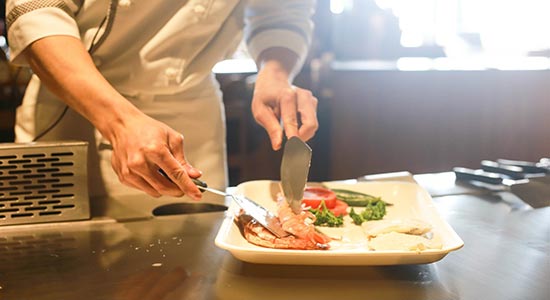
Packaging is the King: Online business is all about right packaging. When you accept the product on time, it is made on time, packed on time, the freshness is maintained. “You would be amaze to know that today dosa is my fastest/ most selling item on the menu. And, it reaches customers with the same crispiness as we make it in our restaurant all because of the packaging we do,” added Thomas.

Efficiency of the Partner: If your partnering with a third party, you need to decide what are the solutions available in the market. Riding with delivery partners is a great choice however, if you want to do on your part you need to be very clear in the scale. “For a customer one can’t have 10-12 app at one point. All brands have to embrace the fact that they need to have 3rd party aggregator for efficient delivery,” pointed Dharmendra Singh, Director – Sales and Operations, Chai Point.
Partnering with third party/existing brand: “It is always helpful to partner with established players because they can reach to places where you may not reach. However, from the data shared by our third party it is very easy to build the model by analyzing what works and how,” shared Prianca Pereira, National Supply Manager (F&B), OYO.

Thus, we can say that cutting-edge technologies, innovative food concepts and a dynamic delivery system are pivotal to dark kitchens to enable them to live up to the expectations of their demanding audience. Dark kitchens economics work out in partnerships with third party delivery apps –which therefore represent an emerging market.

Online food ordering space is one of the paragons in the internet led business space. Funding in the food tech space has grown by 35x in the last five years, shares a BCG- Google report. Macro trends such as rising internet penetration, increasing ordering frequency, favorable consumer disposition, expanding reach in smaller tiers and expanding network of restaurants on Food Tech platforms pan India, continue to drive momentum in the industry.
The report also mentioned that the reach of food tech aggregators has grown six times from 2017 to 2019. At the same time, we see consumers spend more than double the time to explore and order online, from 32 minutes per month in 2017 to 72 minutes per month in 2019. Riding on the wave of higher consumption in a growing market and maturing dynamics on the supply side, we expect the industry to grow from $4 Bn to $8 Bn in next three years, a massive 25% growth rate.
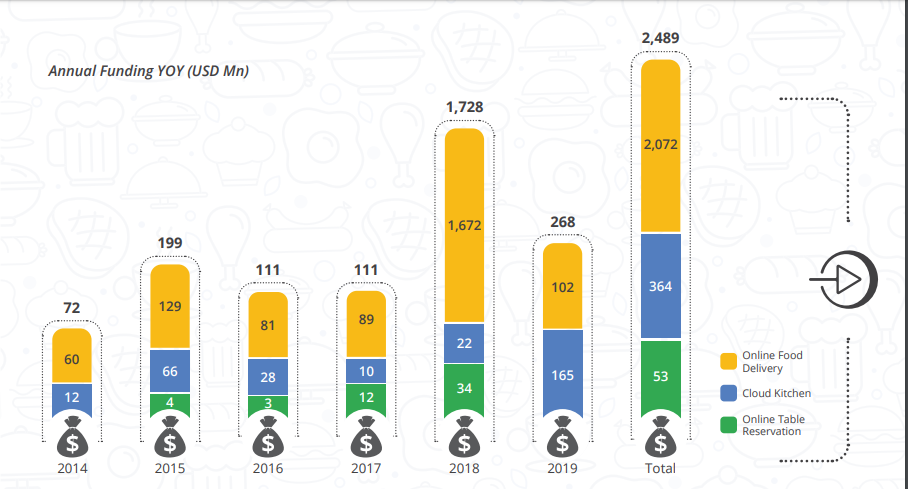
Not only this we have also seen that with food-tech shaping up the online food ordering space, consumers are deeply engaged and have high expectations from these players. Here are five key drivers for the growth of food-tech sector in the country:
Deep personalization: Every customer enjoys some special attention and customization. Lately, food-tech players have worked a lot on personalizing the experience for its customers while placing an order online.
Focused marketing: Food-tech players have got the nerves of the customers and hence they know how to focus on right marketing.
Increased quality assurance: Quality is something that everyone looks at. Quality food is always customer’s first choice when placing an order online. And, these players have partnered with best restaurant partners to deliver quality food.
Constant value for money: Value for money and quality food goes hand in hand. And, food-tech players have everything on board for everyone.
Advanced convenience features: One can easily order, track and see detail about their placed order with advanced convenience features.
Also, diversification is a common theme across global players, making inroads into non perishable delivery (Grocery, Medicine), Cloud Kitchen, Ride sharing, Payment Gateway, OTT Streaming and Hospitality. “We see players leverage their current network of categories, services and consumer to enter adjacent spaces. Established global operators have invested in advanced deep personalization, data analytics, and targeted marketing initiatives, “added the report. Despite all these growth and convenience that online players provide there are some barriers to online ordering.
Barriers in Online Ordering
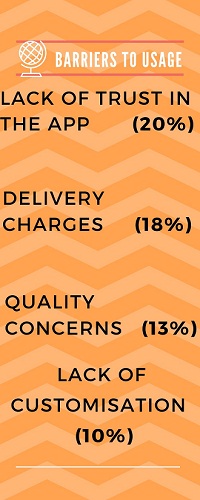
Thus, we can say that in years to come online ordering and food-tech players are going to mark great successes in the industry.

With food innovation, efficiency and focus on consumer experience, there is no denying that online food sector is organizing the unorganized sector. These players are not only tying up with big chains and home grown brands but are also partnering with local mom and pop restaurants that are running a small kiosk or takeaway joints.
“Delivery not in India but worldwide is the fastest growing opportunity and it will continue to grow in that direction. I feel that the cloud kitchen model and the entire system will also grow with time,” shared Prashant Gaur, CBO, Pizza Hut India who believes that to run that system we need to have a hybrid model where you have loads and loads of kitchen which is not visible to consumer but also some equity building signage because cloud ecosystem is over aligned on aggregators and the math is to adopt.
And, as more and more brands are capturing this market, experts believed that the way forward for such platform and the ecosystem is consolidation wherein all partners including restaurant partners, aggregators and consumers need to join hand on how does they want to run the model. “The case for food delivery business is really doing well. In India, we have to go through consolidating factors now and there has to be a right ecosystem phase in case of consumers, aggregators and restaurant partners,” said Vishal Jindal, Co-Founder, Biryani by Kilo.
Not only this, as consumers have got an habit of deep discounting and leveraging freebies, brands today need to decide whether they want to position themselves as a deep-discounting brand or a brand that believes in genuine customer.
“Once a consumer starts paying a lower price for a certain product and when you start to stop giving the discount how many would be willing to pay the full price is a question that probably is not answered because deep discounting is on for quite sometimes now,” added Raymond Andrews, Co-Founder, Biryani Blues that has got a huge fan base in Delhi-Ncr with its amazing range of biryanis and other non-vegetarian delicacies. “Restaurants have to decide on what is their cost of goods and in which they have to build in certain discounts because Indian customers like deals and if you have to play to it. Some brands don’t do any discounts but they are still safe,” he added further.
Commenting on the same Jindal added, “We don’t believe in discounts. We believe in genuine customers who believe in good products and food and not discounting.”

With current ruckus that is going between the restaurant owners and the food-tech company over freebies, discounts and low profit margins by restaurants because of these freebies. The restaurant owners signed a petition requesting the Govt to investigate the issue by citing that these organizations seem to harm the PM’s motive of making India a startup nation. Swiggy and Zomato reportedly denied the accusations.
Also Read: 6 Reasons Restaurant Owners are Annoyed of Food-tech Players
Reverting to the petition signed, a spokesperson at Zomato said, "At Zomato, we believe in providing the best services and experiences to our users; and endeavour to meaningfully help grow the businesses of our partners as well. Our platform lists more than 75,000 restaurants, of which a significant majority is small and mid-size restaurants. We have significantly expanded our online ordering and food delivery services and are currently present across 118 cities in India.”
He also added that the brand has been able to deliver long-term growth for our restaurant partners by connecting them with more users. Infact, a lot of our restaurant partners have been able to expand their operations since food delivery has helped them exponentially leverage the fixed and man-power costs. Discounts are merely a mechanism to encourage user participation and all our restaurant partners can choose to participate in a discounting campaign.
Commenting on the same Spokesperson at Swiggy added, ““Our fair practices have been widely acknowledged by the restaurant community and as a result, in the last 12 months alone, not only have we doubled the number of restaurant partners on the platform to over 55K, but more importantly our partners have seen a two-fold increase in Swiggy’s contribution to their business.”
On the matter of cross holding, Zomato said, "With HyperPure, our aim is to provide organic and residue free fresh produce to all the restaurants at their doorsteps while helping them save on the purchasing cost. The service is only present in Bangalore currently and already has a quality breadth of restaurants. HyperPure has received a great reception so much so that our order list is bigger than what we can currently service. It is helping restaurants save efforts of sourcing food ingredients from an otherwise unorganised market. A small to mid-size restaurant stands to save 10-15% in their monthly expenses on ingredients purchase. We don’t constrain the restaurants on our platform to associate with HyperPure, doing so will be completely against our ethics. Restaurants can choose the HyperPure services if they find them beneficial enough.
"Zomato’s prime objective is to contribute to the growth of the restaurant industry in the country, which we have been doing over the last decade with the help of our various services. We are discussing the matter with the involved restaurant partners to achieve an amicable solution, which would benefit all the parties in the ecosystem.”
The discontent of restaurants against food-tech startups first came into the scene in December 2018, when the Group for Restaurateurs’ Empowerment, Advancement, and Togetherness (GREAT), an independent group comprising restaurateurs across Bengaluru, wrote an open letter highlighting their plight. The association had complained against deep discounting and the private label push on these platforms.
The group had also called for meetings and encouraged customers to order via a call or through the restaurant website. In the last few weeks, several restaurants have been observed as being “closed for online ordering” on platforms such as Zomato and Swiggy.
Also, Hotel & Restaurant Association of Gujarat wrote a letter to the Zomato Regional Head, asking restructuring of the online ordering commissions, discounts, payment and cancellation policies. The letter read, “At the onset we would like to thank you for providing decent business to the city of Ahmedabad. However, off late it is becoming difficult for the restaurants to make any profit from business provided by your company.”
The Organization has also invited all the stakeholders and representatives of these food tech players for a meeting on 10th January. Also, NRAI will also be holding a meeting with these players in its headquarter this week.

In the last few months we have seen food-tech companies alluring customers with freebies and offers that are not even valid at many restaurants creating a ruckus in the industry. Restaurateurs felt that these food-tech companies are not only enticing customers by these deals but are also trying to wipe out small medium enterprises. But, as they say – all that shines is not glitter. Soon, the sector became overflowed with ‘me-too’ startups lacking both – differentiation and innovation. Here are 5 Key Reasons Restaurant owners are annoyed of food-tech players including the likes of Swiggy, Zomato and UberEats.
Unviable Discounts: This has become a new norm by these food-tech players to lure customers. They have been offering temporary discounts below the cost price to customers. This is not only creating a hindrance in the business of top restaurants but is also making small restaurants face losses and many even faces the shut down. “Unlike retail, FDI (foreign direct investment) restrictions are not applied on the restaurant sector or food service aggregators. As an association, we have a roundtable discussion next week with all four major food delivery aggregators to address deep discounting and the cloud kitchen issue, which is adversely affecting the restaurant industry,” shared Rahul Singh, President, National Restaurant Association of India (NRAI), which represents over 5,000 brands last week.
Creating in-house Kitchen: Players like Swiggy have started their own kitchen- The Bowl Company wherein they direct customers to order from their in-house kitchen. This is not only misuse of customer data but also for restaurants that pay hugely to get listed on such platforms.
Focusing on Self Promotion: No matter the restaurant owners are paying huge tariffs players like Swiggy is promoting their own kitchens rather than restaurant partners. Whenever, a customer login into the Swiggy website they will see the in-house advertisement first. This clearly is misusing customer database who visit such platforms to order food to their own kitchen.
In-house Suppliers: Players like Zomato has started in house company called Hyperpure. This company sells vegetables, chicken and other meat and forces restaurant listed on Zomato to raw materials from this company.
Hampering Margins: With such discounts available restaurants are facing low margins making loss of business and failing to achieve profit out of any food-tech companies.
Offering Freebies and Discounts: A few years ago, the biggest problem was “discovery” of restaurants. People faced problem in figuring out restaurants that were available nearby and how good they were? Companies like Zomato absorbed this pain by building a simple platform to address the problem of the Indian foodies. But as we witnessed more and more startups doing the same, we see these players offering freebies and discounts to attract customers to use their platform.
According to sources, restaurant owners in India have filed a petition asking Govt to help curb an unsustainable pricing by these tech-players, ban cross holding and appointing a food regulator food in each state by the food and civil supplies ministry to ensure that the rule is not breached to overcome cut throat competitions.

As Indians are continuously experimenting with food, it has become an integral part of the conducive business in the country. We see people travelling a lot these days in search of good food and experience culinary repertoire of regions and nations pushing a region wise food trend in the country. Gone are the days when Asian food was limited to Chinese cuisine, restaurants today are offering much more than Chinese and Japanese. Pan Asian cuisine is the new wave in the market with speciality restaurants breaking all food myths. This has pushed a new trend in the industry giving a way to lots of Pan Asian food delivery online place opening up. Cities like Delhi, Bengaluru and Mumbai has already witnessing this change but smaller cities are also joining the bandwagon and setting up speciality delivery places.
Why delivery?
Kula Naidu who was one of the first entrepreneur to set up this trend by setting up only delivery places Asian Haus and Sushi Haus in Delhi four years back today see the great potential for the segment and feels happy to see the awareness of comfort asian food growing in the market. “We realized there are a large demand for delivery and the scarcity for good comfort Asian Food. Our focus is on emphasizing the experience of food delivery and extending it towards a complete brand,” added Naidu who believes that Asian food has a large popularity and is well understood by Indian customers. Since, there haven’t been any places that cater in the same capacity as us, it was our calling. With Italian food, it’s unexplored territory, he further pointed.
Similarly, Joseph Cherian who has spent a substantial time in Asian countries working as CEO of GFA Global and Papa John’s India, he always enjoyed Asian flavours and always dreamt of bringing those flavours back to India. He together with his friend and chef Nabhojit Ghosh under Love Food Ventures Pvt Ltd started 48East which is marked by a multiplicity of regional and ethnical influences. The start-up is representing foodies trail from around 48 countries.
“I spent most of my working years in Asia and Middle East and always felt the need of gourmet Asian food home delivered in India during my stay in India. What is typically available in India for home delivery were home grown Indo- Chinese brands. In addition to the Indo-Chinese food, Asian food was typically a Thai Green curry or red curry, Malaysian, Singapore noodles etc,” shared Kurian who thought of bridging this gap.
Getting the right raw materials
Asian food is all about the complex flavours. Hence, getting the best raw materials is the important aspect of this cuisine. Though, with modernisation and global trade some ingredients can be sourced locally but for few one need to get it flown from their home location to meet the authenticity of that land.
“We have tied up with various suppliers to supply us with both locally sourced and imported ingredients. We need to import some of the items to ensure authenticity of the dished,” added Kurian.
Sharing on the same, Naidu pointed, “a lot of the raw materials required are available in Delhi. Supply does end at times and we can’t do much about till new stock arrives. We deal with vendors who import these raw material from Thailand and Japan majorly. Sourcing is a lot easier in Delhi as it’s the capital.”
And, as we see this trend catching up fast with new players venturing in the space, a lot more focus is showered on presentation and delivery of the food.

Please share your entrepreneurial journey and what led to the birth of your brand?
The trio Hemal (Desai), Harsh (Vardhan) and me were friends over a decade. Passionate foodies and weekend chefs brings a unique flavour to the palate called Cook’dIn. Motivated thought empowering people made us start Cook’dIn as a catalyst and facilitator. Cook’dIn creates a primary/secondary revenue stream for homemakers and low income groups for home-cooked food. It is a convergence platform, which aspires to be a worldwide phenomenon, truly empowering individuals on what they cook/eat, when they cook/eat, where they cook/eat and also reducing the cost of what they cook/eat.
What are the challenges in growing your business i.e. maintaining standards, brand integrity, customer experience etc and how have you met these challenges?
We have planned all the challenges for the road ahead. This plan includes brand building, health and hygiene standards, customer experience etc. We are also striving to achieve applicable ISO standards and FSSAI (which is yet not applicable on home cooked meal), within next 12 months.
Do you have a growth targets for the next few years and can you reveal any strategy to achieve this?
To start with we are eyeing a potential serviceable customer base of 1.1 lakhs, out of the targetable 4.4 lakh households. Home chefs, who are registered on Cook'dIn have a huge marketplace to cater as there are not many restrictions on home chefs they continue to remain their own bosses. The yearning in urban households for ‘Ghar ka Khana’ is what spurred the idea of Cook’dIn.
We expect to add Tier II city by the end of third or beginning of fourth quarter in our operations. The target is to be able to cover 7-8 cities by the end of three years. We have prepared this business model with in depth market research for over nine months from the beginning of 2015.
Do you change your menu daily? What all is required in designing menu?
The menu is driven by home chefs, who desire to cook as per consumer’s want. The trend analysis is based on feedback provided to home chefs to make suitable changes.
Where would you like to see your brand in the next five years?
We are expecting to cover all cities, targeting mainly in India by fifth year of operation. At the same time we would have established beach heads in cities like Europe, S.E. Asia, Middle East and Latin America. We have already done in depth market research for North American market and will take appropriate steps.
As we have seen lots of chef-driven start-ups in 2014-2015. What makes you unique from them?
Our USP is ‘Home Chefs’. We are planning to bring amazing variety of cuisines on board, both Indian and Global. Cook’dIn is a ‘convergence platform’ for home chefs and consumers, from different parts of India and world.
Our ‘free market approach’, sets us apart from others. There are other critical aspects to our business model, which makes us unique i.e. Logarithm based Food Allergy match with meal ingredient, low price and high quality meal delivered at your food step, average meal price for a home delivered meal is Rs.480; we also expect to have our average price in vicinity of Rs. 250 and many more.

How was Swiggy born?
The driving principle behind Swiggy is to revolutionize the restaurant-takeaway-delivery business in India. Food delivery in India is fraught with problems both on the consumer as well as the restaurant end. The problems on the consumer end range from reliability and consistency in service, restaurant unavailability and high minimum order values etc. On the restaurant end the overheads pertaining to the maintenance of a fleet of delivery staff, high rentals and marketing costs lend credence to disruption. Since then Swiggy has evolved as a leading marketplace connecting customers to their favourite eateries with the motto of “No customer goes hungry”.
Swiggy is planning to set up kitchens jointly with restaurants for higher revenues. Share about the plan?
Swiggy intends to work with the best restaurants in creating delivery-first restaurants or cloud kitchens. The mechanism is still under discussion but the core idea is to help restaurants with generating demand and managing the logistics for them while the restaurants themselves can focus on the preparation of food. There are multiple means to achieve higher revenues-investing in these kitchens is one of the options.
What are the challenges you are facing in the operation?
Food delivery in India is a pretty nascent industry, having just taken off in the last year. Initial challenges include familiarizing restaurant partners to the business model, gaining customer traction to scaling the delivery fleet with individuals who understand the nuances of food delivery. We have come a long way since then and the traction we are receiving in new markets we are entering stands testimony to the fact that the restaurant delivery business is undergoing a major change.
On what basis do you provide recommended menus to customers?
In addition to personalized menus, users can also sort or filter based on their preferences corresponding to cost, time of delivery, rating, popularity, cuisine etc. We also have a set of recommended dishes from a restaurant along with accompanying photos which assist users in faster checkouts. Overall we are trying to optimize customer experience to enable checkouts within a minute. Besides these data-driven parameters, our visual menus guide customers through what we have picked as the best items from a particular restaurant.
How much competition do you face from Zomato, Tinyowl or Foodpanda?
Swiggy is not just a lead-generation solution but is also focused on solving the key problem of logistics in food delivery. Even the business model is different than the other players in the market. Swiggy’s objective is to integrate with restaurant partners and provide an optimal experience to our customers. Therefore, Swiggy has a no minimum order policy and is currently the only service in the market to offer live tracking of orders.
How has technology played a pivotal role in making ordering seamless on Swiggy platform?
Swiggy is a core-logistics platform and thus, leverages technology heavily in order to provide the best of services to the restaurants as well as customers. Customers currently have an option to place orders through either the website or the mobile apps (iOS or Android). We use other factors such as traffic conditions, historically determine preparation time of restaurants, location of delivery executives to “smartly” determine the delivery time promise to end customer. Customers can even live-track their order from time of confirmation to delivery on a map. Today, our service level agreement compliance is above 80 per cent and growing.
To our restaurant partners, we provide a system which not just relays orders but provides them a snapshot of the financials as well as key operational metrics. Our delivery partners are equipped with state of art mobile technology that selects the best resource to fulfil the order apart from guiding him on the routes. On the back end, our analytics engine periodically mines customer data to understand user preferences, which helps us partner with the right restaurants.
How do you see social media as a marketing medium?
During the recent past, social media has risen to prominence, especially as a vital marketing tool. Since social media is now extremely popular, with huge numbers skimming through content for a large part of a typical day, it is a crucial tool to market through, for the sake of simply reaching a vast audience. Social media also provides clever targeting for increased viewership, helping marketing land much closer to the intended mark.
What is your expansion plans?
We are already present in eight cities– Bengaluru, Hyderabad, Mumbai, Pune, Delhi, Gurgaon, Kolkata and Chennai. Our core objective is to ensure widespread proliferation in all the cities we are currently operational in. Then, we will plan to expand to four to six more cities within the next year. Our goal is to revolutionize the way India eat and in covering all major cities.

How do you go about designing your menu?
We work hard to ensure our menus are balanced every day. Seven key parameters are considered in designing our daily menus, including veg/non veg mix, Indian and international foods spread, pricing range, dish types etc.
It is important that our customers who have diverse food preferences have their needs met. One of the advantages MealTango has over the conventional restaurant is the fact that all the foods are made by experts in their own right. So, we aren't limited by one head-chef and his range of expertise. We have a large number of home chefs each exhibiting their strong suite of skills.
What are the new recipes you have developed over a period of time?
The great thing about MealTango is that we are constantly unearthing a wide range of dishes customers have never experienced before. For example, we were the first ones to make 'Pathare Prabhu' cuisine available to the masses. The Pathare Prabhus are the original inhabitants of Mumbai and only 6,000 or so are in existence and their cuisine even includes unique European influences like quiches and pies.
We also have brought to the fore, authentic Anglo Indian fare, South African dishes like the Bunny Chow and Sosaties and many other unique dishes people may not have experienced before. At the same time, 'ghar ka khana' is ever present on our menu, so if you aren't the food adventurer and yearn for authentic homemade food, you can get that every day from MealTango.
What are the challenges you face at the time when you get numerous orders?
We pride ourselves on our USP that our food is NOT bulk produced, is preservative-free and never older than a day. Our home chefs are never pushed to produce food in large quantities, beyond the numbers they are comfortable with.
Therefore, due to extreme surges in demand, just like in restaurants have waiting, we have stock outs. However, we are constantly adding talented home chefs to our network and will be able to serve very large number of customers.
How do you decide the pricing of the menu? What are the elements you keep in mind?
One of our key values at MealTango is that our home chefs should receive handsome remuneration. We believe this means that people are enjoying their food and recommending it to their friends. It also serves as solid validation that our model is working. For this reason, we have a very transparent pricing model that rewards our home chefs for their efforts. In fact, our home chefs make the lion’s share of revenue on each sale. Our model accounts for fluctuations in ingredient prices, and desire for bulk discounts from our consumers, while keeping our home chefs' interests in place.
Do you see any threat from your competitors?
When others see success, competition in any sector is a natural phenomenon. We welcome competition, as it helps bring in efficiencies in the market and keeps us on our toes. Another one of our key values is customer delight. I believe more competition will establish the home chef market, and give customers more confidence in making healthy food choices.
We believe that our focus on customer delight will be our key differentiator. We keep our eye on growth and are intent on achieving sustained 50 per cent plus growth month on month (we are currently hitting almost 100 per cent growth MoM).
Meal Tango arranges festival-based experiences or cooking workshops. How does this help your website in return?
These are excellent opportunities for prospective customers to try MealTango food in a friendly arena and have fun! It's also a good touch point for us to interact with our customers. After all, great food and great times go together.
What is your expansion plan in terms of numbers of outlet and cities?
We are looking at expanding to 100 plus delivery hubs across all metros within the current financial year.
How do food sites help to attract investors and customers?
Yes, we are very attractive to both - investors and customers. In fact, we are looking for full time staff to work with investors due to a large amount of interest in MealTango.
In terms of customers too - all our marketing is done through word of mouth, at present. Our marketing budget is less than the average family bill at a restaurant! Even with this minimal marketing spend; we are seeing almost 100 plus MoM growth.

More than 3 billion meals are consumed by long-distance train travellers every year. Yet, access to food inside train coaches is a major challenge. Food vendors empanelled by the Indian Railways offer a limited choice of poor quality, un-hygienic and overpriced food. Pantry cars are known for abysmal food preparation quality and service. And this has given Pushpinder Singh a channel to start something of his own, where he could provide food to travellers.
How the innovative idea of starting TravelKhana initiate?
As an avid traveller I realised that despite having so much technology to serve people buying tickets or hotels, the travellers still experience discomfort when it comes to obtaining services on the move. If that is solved, travellers in India can travel much more comfortably as they will not be limited by their movement and not be victims of unscrupulous food vendors, taxi cab operators and the like. A marketplace was the natural choice for such a problem to be solved. As it was simply impossible for a start-up to have the resources to do everything – from producing/merchandising the supply to managing the market and technology, so we focussed on the single biggest problem. Food in train was thus an obvious choice to be solved.
TravelKhana’s platform tracks train running information to insure meal delivery at the right time, at the right seat, that is fresh and ready to eat. The entire process is managed by a completely automated workflow that sends real time reminders to passengers as well as restaurants so that the entire process can happen smooth and fast.
What special menu does TravelKhana provide for customer travelling via rail?
Travelkhana has been a marketplace for restaurants wherein the menu of the restaurants is listed for the customers to order from. Over the course, we realised that options listed in the menu are limited; also, the predictability on the service provided by restaurants is low. As a result, we decided to standardise across the board.
Starting Sep-1, 2015, we have standardised menus and prices across the board. Along with the standardisation, we are also building a quality and processes layer that will control the restaurants and their quality. Our quality and audit team will work with such restaurants to bring up their quality to a uniform standard. Along with this, we will also have a feature of “featured restaurants” wherein large brands or local specialties can be listed as featured restaurants. This way we serve the long tail as well as the mass market needs.
Which route is your most revenue generating? What is the reason behind the same?
Trunk routes between major metros like Delhi, Mumbai, Bengaluru, Kolkata, and Chennai are the highest revenue generating.
What are your views on the FSSAI law and its take on food product?
We think the FSSAI is an encouraging step. As a part of our standardisation drive, we insist that FSSAI is a minimum must besides other standards that restaurants must take up.
Are you planning to provide meals in bus etc.?
Yes. We are in the middle of planning this. We will do 4-5 major southern cities to start this activity.
What is your expansion plan?
We will increase our depth in the cities we are present. Besides, we will locate ourselves in 400 stations from the current 160. We are increasing ground presence at these stations and building regional teams under regional managers covering a region. Southern market is a market where our presence earlier was limited. We are increasing our penetration there. A tie up with IRCTC is on the cards.
Additionally, we think that the need of good food for highway travellers is also a big requirement. We will get into that as well soon as our standardisation drive gets underway.
Tell us something about your business model?
We earn commissions on food delivered through us.

Over the years, e-commerce buzz is heating the fast evolving restaurant space in India. Gone are the days, when people are restricted to ordering food via certain aggregators or players like Zomato, Dineout amongst others. Today, not only customers’, but restaurant owners also look at ease of experience to their loyal and regular customers’.
Making the ‘mobile’ way
“We have a high repeat customer base, and wanted to offer them ease of use for all their Chaayos experiences, be it takeaway pre-ordering, home delivery or their loyalty program information. The delivery app is the first step to improve your experience at Chaayos,” shared Raghav Verma, Co-Founder, Chaayos.
With number of Smartphone users rising in India, the m-commerce market to reach $19 billion by 2019, leaving behind unexplored opportunities to grow smooth business.
According to a report, “right from user research to product anytime and anywhere, smartphones are an emerging point of purchase changing consumers shopping pattern.”
Recently, Big Fish Ventures, which runs some of the wackiest cafes and restaurants in Delhi has come up with their own app making their customers’ more loyal towards their brand.
"Most firms are focused on creating single brands with standardized formats like, for example, a McDonald's or a KFC. We are building a cluster of concept--based different brands across genres and large formats," pointed Umang Tewari, Owner, Big Fish Ventures.
Neck to neck competition
However, this trend is very niche in restaurant business scenario in the country, but it may set a trend for large multi format restaurant chains and cafes developing their own apps and eventually posing competition to the specialized dining and reservation app operators like Zomato, Dineout, Easydiner and Reserveyourtable.
"We will bring over 2 lakh customers on our mobile app by end of 2016 and will be doing over 5000 table reservations per day by June 2016. We plan to invest over 3-4 million dollars over next 3 years," added Tewari who is excited with new development in the country.
As consumers are much more focused on buying or ordering a product or getting the best offers through their smartphones, this may push the industry to experiment with the app opportunity. Likewise, Chaayos, which was the first cafe in India to have their app gets majority of their delivery revenue, comes from Chaayos app.
“The response has been amazing, we have 300% higher repeat orders than our other channels, and a majority of our delivery revenue comes through Chaayos App,” pointed Verma who sees Zomato and Dineout as partners and not a competitor.
However, these promotions are marketed through their own cafes and through social media marketing, it could gain more traction capturing the younger generations.

Year 2015 was a year of excitement for food and restaurant industry. From attracting investors to bringing the global brands to India, the year has seen lots of development when it comes to eating and ordering food. And, as this was the year of food-tech, the online ordering has witnessed a tremendous growth when it comes to making money.
Players like Zomato which launched its online ordering platform eight months before in India and thereafter in the UAE has found the journey incredible so far.
“We are currently present across 14 cities in India with over 15,000 restaurant partners and counting. The business is growing at 50% month-on-month and we believe that, in about a year, online ordering will contribute to at least 20% of the overall revenue of the company,” states a Zomato release.
Cuisine that ruled the heart
I always wonder how India has given a special treat to its varied cuisines, from north to south and from east to west, each region have its own specialities. And nonetheless to say, each cuisine has made a way into the people’s heart. From getting the best spices from across the regions, to cooking the specialised foods in a traditional format, Indian cuisine is wonderfully crafted. But, when it comes to the most popular, most loved and most ordered cuisine, North India has left all other cuisine way behind. One could say that the region is well expanded and has beautifully presented its cuisine not only in Indian market but also in global diaspora.
Researches shows that North Indian cuisine has ruled the favourite list for more than a decade now, followed by Chinese, Italian, South India and healthy food which is a new add into the list with younger generation becoming more health conscious and fitness freak.
Favourite food
Though 2015 was year of experiments, developments and service, traditional Indian cuisine ruled the nation when it comes to the largest made deliveries. According to the Zomato, Biryani was the favourite food from all regions followed by Burger, Butter Chicken, Pizza and Hakka Noodles. Hence, we could say, how globalise we become, Indian food be the first preferred choice when it comes to making the largest number of transactions.
Payment methods
When it comes to food, people has always loved to go out and have their time at their favourite restaurant and food joints, but 2015 has brought the welcomed the online delivery with open arms. With cities like Kolkata taking a lead in getting the highest food delivered to their order, Delhi, Hyderabad, Mumbai, Chennai and Bengaluru too joined the race with a fresh start.
However, COD was always preferred when the food was ordered home; this year also saw many new changes via other payments mode. Services like card payment, wallet shares and net banking made a way into people heart for payment options.
And as 2016 welcomes the foodies, the year could be a game changer for the sector seeking a growth of approximately 20-25 per cent.
Infographics: Zomato

Zomato, the restaurant search engine, which has entered into the food delivery space in April, has launched Zomato Order, a separate app from where customers can order food.
Always focused on condensing tons of information into a ridiculously easy-to-use app, Zomato Order is being touted as second big app after Zomato Cashless. The company says, Somewhere along the process of testing and rebuilding, and the hundreds of feedback emails we received, we realized we had to make a decision we were trying to put off for as long as possible – unbundling our apps. And Zomato points at three major reasons for this app.
More focus = less clutter = better UX
- ​Having two separate apps allows Zomato to build lightweight apps that get straight to solving the problems customers face.
- Actions that are core to the app experience can be given priority of position, and Zomato isn’t forced into making real estate compromises. For example, tracking your Order Status in the Zomato restaurant finder app requires a few taps; on the Order app, it gets its own tab. This might be the first time Zomato will be happier with shorter app session times :)
Independent release cycles = fewer updates
- While they might be part of one complete dining flow, using Zomato to search for a place to eat, and using Zomato to order online are two independent use cases for our users.
- Baking the ordering feature into the restaurant finder app might seem like the convenient thing to do, but that means having to coincide release cycles for two effectively different products in one. Unbundling them allows us to devote attention to both apps independently, iterate quickly, and push updates for either one as required.
Deep-linking = smoother app experience
- As is the case with most unbundled apps that come to mind, the Zomato restaurant finder app and Zomato Order will be linked to one another. So if you’ve found a place you want to order from on the restaurant finder app, a single tap will take you to that restaurant on the Order app, and you can proceed to add items to your cart.
- Once done, a single tap will take you back to the restaurant finder app, so you can decide what to do for your next meal (obviously).
In short, the long-term benefit of unbundling Zomato apps seems to outweigh the short-term downside, and aiming to make the process of using Zomato – whether it’s for search and discovery, or for ordering online – a simpler and smoother process for everyone, Zomato is really the market leader.
Zomato Order is now available for download on the App Store and the Play Store.
Copyright © 2009 - 2025 Restaurant India.














